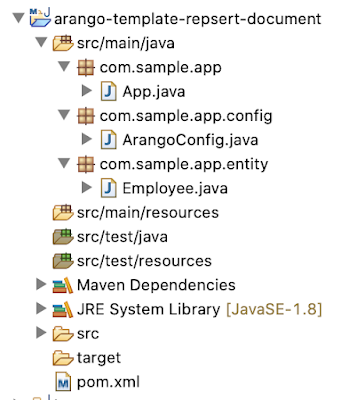Spring Data ArangoOperations interface provides ‘repsert’ method, which creates a new document from the given document, unless there is already a document with the id exists. In that case it replaces the document.
Signature
<T> void repsert(T value) throws DataAccessException;
Example
arangoTemplate.repsert(emp);
Step 1: Create new maven project ‘arango-template-repsert-document’.
Step 2: Update pom.xml with maven dependencies.
pom.xml
<project xmlns="http://maven.apache.org/POM/4.0.0"
xmlns:xsi="http://www.w3.org/2001/XMLSchema-instance"
xsi:schemaLocation="http://maven.apache.org/POM/4.0.0 http://maven.apache.org/xsd/maven-4.0.0.xsd">
<modelVersion>4.0.0</modelVersion>
<groupId>com.sample.app</groupId>
<artifactId>arango-template-repsert-document</artifactId>
<version>1</version>
<!-- https://mvnrepository.com/artifact/org.springframework.boot/spring-boot-starter-parent -->
<parent>
<groupId>org.springframework.boot</groupId>
<artifactId>spring-boot-starter-parent</artifactId>
<version>2.4.5</version>
</parent>
<dependencies>
<dependency>
<groupId>com.arangodb</groupId>
<artifactId>arangodb-spring-boot-starter</artifactId>
<version>2.3.3.RELEASE</version>
</dependency>
</dependencies>
<build>
<plugins>
<plugin>
<groupId>org.springframework.boot</groupId>
<artifactId>spring-boot-maven-plugin</artifactId>
</plugin>
</plugins>
</build>
</project>
Step 3: Define entity class.
Employee.java
package com.sample.app.entity;
import com.arangodb.springframework.annotation.ArangoId;
import com.arangodb.springframework.annotation.Document;
import org.springframework.data.annotation.Id;
@Document("employees")
public class Employee {
@Id // db document field: _key
private String key;
@ArangoId // db document field: _id
private String arangoId;
private Integer id;
private String firstName;
private String lastName;
private Integer age;
public Employee(Integer id, String firstName, String lastName) {
super();
this.id = id;
this.firstName = firstName;
this.lastName = lastName;
}
public Employee() {
}
public String getKey() {
return key;
}
public void setKey(String key) {
this.key = key;
}
public String getArangoId() {
return arangoId;
}
public void setArangoId(String arangoId) {
this.arangoId = arangoId;
}
public Integer getId() {
return id;
}
public void setId(Integer id) {
this.id = id;
}
public String getFirstName() {
return firstName;
}
public void setFirstName(String firstName) {
this.firstName = firstName;
}
public String getLastName() {
return lastName;
}
public void setLastName(String lastName) {
this.lastName = lastName;
}
public Integer getAge() {
return age;
}
public void setAge(Integer age) {
this.age = age;
}
@Override
public String toString() {
return "Employee [key=" + key + ", arangoId=" + arangoId + ", id=" + id + ", firstName=" + firstName
+ ", lastName=" + lastName + ", age=" + age + "]";
}
}
Step 4: Define arango db configuration.
ArangoConfig.java
package com.sample.app.config;
import org.springframework.context.annotation.Configuration;
import com.arangodb.ArangoDB;
import com.arangodb.springframework.annotation.EnableArangoRepositories;
import com.arangodb.springframework.config.ArangoConfiguration;
@Configuration
@EnableArangoRepositories(basePackages = { "com.sample.app" })
public class ArangoConfig implements ArangoConfiguration {
@Override
public ArangoDB.Builder arango() {
return new ArangoDB.Builder().host("localhost", 8529).user("root").password("tiger");
}
@Override
public String database() {
return "abc_org";
}
}
Step 5: Define main application class.
App.java
package com.sample.app;
import org.springframework.beans.factory.annotation.Autowired;
import org.springframework.boot.CommandLineRunner;
import org.springframework.boot.SpringApplication;
import org.springframework.boot.autoconfigure.SpringBootApplication;
import org.springframework.context.annotation.Bean;
import com.arangodb.entity.DocumentEntity;
import com.arangodb.springframework.core.ArangoOperations;
import com.sample.app.entity.Employee;
@SpringBootApplication
public class App {
@Autowired
private ArangoOperations arangoTemplate;
public static void main(String args[]) {
SpringApplication.run(App.class, args);
}
@Bean
public CommandLineRunner demo() {
return (args) -> {
Employee emp1 = new Employee(1, "Shanmukha Rao", "Kummari");
Employee emp2 = new Employee(2, "Sailaja", "PTR");
DocumentEntity docEntity = arangoTemplate.insert(emp1);
arangoTemplate.repsert(emp2);
Iterable<Employee> emps = arangoTemplate.findAll(Employee.class);
for(Employee emp: emps) {
System.out.println(emp);
}
System.out.println("\nReplacing the document using repsert method\n");
String id = docEntity.getId();
Employee newEmp = new Employee();
newEmp.setArangoId(id);
newEmp.setFirstName("Shanmukha Rao Kummari");
newEmp.setAge(33);
newEmp.setId(1);
arangoTemplate.repsert(newEmp);
emps = arangoTemplate.findAll(Employee.class);
for(Employee emp: emps) {
System.out.println(emp);
}
};
}
}
Total project structure looks like below.
Run App.java, you will see below messages in console.
Employee [key=37873, arangoId=employees/37873, id=1, firstName=Shanmukha Rao, lastName=Kummari, age=null] Employee [key=37876, arangoId=employees/37876, id=2, firstName=Sailaja, lastName=PTR, age=null] Replacing the document using repsert method Employee [key=37876, arangoId=employees/37876, id=2, firstName=Sailaja, lastName=PTR, age=null] Employee [key=37873, arangoId=employees/37873, id=1, firstName=Shanmukha Rao Kummari, lastName=null, age=33]
You can download complete working application from below link.
https://github.com/harikrishna553/springboot/tree/master/arangodb/arango-template-repsert-document
Previous Next Home

No comments:
Post a Comment